From Midtown Law Partnership to Scarsdale Volunteer Arena: Richard Toder Makes it All Look Easy
- Details
- Hits: 10178
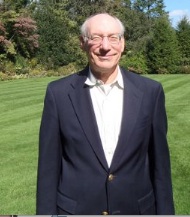 Longtime community resident Richard Toder has set a high bar for voluntarism in Scarsdale. While working grueling days as a partner and chair of law firm Morgan Lewis and Bockius’ Bankruptcy and Financial Restructuring Practices (in 1997, he was one of twelve attorneys listed by Turnarounds and Workouts as “top bankruptcy lawyers” in the country), Toder has volunteered in some of the most significant civic organizations in Scarsdale, including: the Town Club (now the Scarsdale Forum); Citizens Nominating Committee; Board of Appeals; Board of Education (where he served as its president in 1995-1996); Village of Scarsdale board of trustees (from 2008-2012 he variously served as deputy mayor and as chairman of the Law, Recreation, Land Use, and Personnel committees); and currently as President of the Scarsdale Foundation. Known for his brilliant mind, strong work ethic, and incisive wit, Toder has mentored generations of Scarsdale volunteers by teaching through example that there’s always time in the day to give back to the community, no matter how busy one is.
Longtime community resident Richard Toder has set a high bar for voluntarism in Scarsdale. While working grueling days as a partner and chair of law firm Morgan Lewis and Bockius’ Bankruptcy and Financial Restructuring Practices (in 1997, he was one of twelve attorneys listed by Turnarounds and Workouts as “top bankruptcy lawyers” in the country), Toder has volunteered in some of the most significant civic organizations in Scarsdale, including: the Town Club (now the Scarsdale Forum); Citizens Nominating Committee; Board of Appeals; Board of Education (where he served as its president in 1995-1996); Village of Scarsdale board of trustees (from 2008-2012 he variously served as deputy mayor and as chairman of the Law, Recreation, Land Use, and Personnel committees); and currently as President of the Scarsdale Foundation. Known for his brilliant mind, strong work ethic, and incisive wit, Toder has mentored generations of Scarsdale volunteers by teaching through example that there’s always time in the day to give back to the community, no matter how busy one is.
A graduate of Columbia University and Harvard Law School, Toder is an inspiration to those who have worked with him in Scarsdale over the years. Rita Golden, who served with Toder on the Board of Education, had these words to say about him: “I was always impressed by his ability to cut through the weeds and get to the heart of an issue, define the options, and come to an intelligent conclusion, often with just the right humorous comment to lighten the moment.” In an effort to highlight people in the community who have made our volunteer institutions so effective, we asked Richard to share his recipe for success. Here’s what he told us:
What initially attracted you to Scarsdale and when did you move here?
My wife, Joan, and I moved here in 1975. We knew that Scarsdale was a great place to raise children and that it had one of the finest public school systems in the country. Our children went through the Scarsdale schools and got a great education. Our son David is an architect and our daughter Elizabeth works for an NGO in microfinance. I should add that we have six grandchildren!
How did you first become involved in the volunteer sector? What was your first volunteer commitment in town?
I got involved almost immediately! One of our neighbors encouraged me to join the Town Club and I became active in some of their committees. I was struck by the fact that you could move up in the system rapidly if you were just prepared to do some work. I became a chair of a committee in a matter of a few years.
You have served on two of the most significant and time-consuming boards in town: the Scarsdale Board of Education and Village of Scarsdale board of trustees. How have you been able to balance your work responsibilities as partner of a major law firm with these demanding volunteer commitments?
One thing that the practice of law does is to quickly force one to develop the discipline and ability to multi-task in a way that allows one to work as efficiently as possible. Having said that, the key is to have to have an understanding spouse…Joan has always been great at putting up with me! When I was Board of Education president I was also working on the Barney’s bankruptcy, representing the agent bank. Yet somehow there was time to do both!
What was the most significant issue you tackled on Board of Education?
When I was Vice-President, the community became embroiled in a discussion over whether the schools – and in particular the elementary schools -could teach not religion per se, but a better understanding of different religious holidays and traditions celebrated by Scarsdale students. As an attorney, I was assigned to look into the constitutionality of whether Scarsdale, as a school system, could have a generalized teaching unit on multicultural holiday traditions. Entirely aside from constitutionality, the real issue was tolerance, and instilling a recognition that different customs and traditions should be respected by all of us. It began as quite an emotionally charged issue, which had the potential to be extremely divisive, but fortunately the result of the dialogue was that a holiday policy was developed that was both educational and sensitive to the diverse views held by residents in the community. I was very proud of how the community came together on this issue. [Notes former Board colleague Rita Golden, “Richard’s presentation on the final night we were debating the issue at a board meeting before the voting was masterful, a detailed legal brief where he noted each concern and laid out the legal rationale behind the decision. It was masterful and one of the most remarkable speeches I have ever heard a board member deliver.”]
You most recently completed a four year term as trustee and deputy mayor of the Village of Scarsdale, chairing their committees on Law, Recreation, Land Use, and Personnel. What do you believe are the challenges facing our village in the next several years?
I believe that balancing the residents’ desire for continued high level of service while at the same time keeping tax increases modest will continue to be our greatest challenge. That’s nothing new, but in today’s economy it is an even more pressing problem.
What’s an example of a difficult issue that was resolved when you were a trustee?
The tree law is a great example- I think we came up with a balanced approach, and that’s how the system should work. Relatively extreme positions on both sides – total regulation of all tree removal (regardless of the size or number of trees involved) versus no regulation at all because of the primacy of property rights – were modified so that we ultimately passed an ordinance which accomplished the purpose of keeping Scarsdale beautiful without unduly restricting the ability of homeowners to make decisions concerning their own property.
As the new president of the Scarsdale Foundation, what do you hope to accomplish in your term of office?
Despite the fact that the Foundation has been in existence since 1923, it is not as well known in the community as it should be, and I hope to help engender a sense of understanding among our residents of the importance of our work. When people think of the Scarsdale Foundation, if they do, they think about it as the presenter of the Scarsdale Bowl award, given annually to a citizen who has contributed outstanding volunteer service to the community. But we do so much more! Our college scholarship grants enable us to help children of our village who would otherwise, because of financial constraints of their families, be unable to attend college. And after all, we all came to Scarsdale in large part because of the importance of education for our children. This year, we gave out $97,000 in scholarship money to 26 sophomores, juniors and seniors in college, thanks in part to generous donations of many supporters in the community.
Our summer day camp program is even lesser known: through a confidential process, the Foundation makes grants to Scarsdale children who are in need of assistance so that these children are able to attend the Scarsdale Recreation Department summer day camp. Our recipients have significant financial challenges and the benefits for these children being able to enjoy camp are so important. A more complete listing of Scarsdale Foundation programs follows this article.
Many people believe that all Scarsdale residents are well-to-do and don’t need financial assistance. Is that a myth?
Many Scarsdale residents are very fortunate. But there is a pervasive, albeit incorrect, view that all residents of Scarsdale are well-to-do, and that’s not true. Especially in these challenging economic times, many families in Scarsdale are hurting. The Foundation – which is dedicated to the betterment of the community in the broadest sense - assists its families who struggle in meeting the ever-increasing costs of a college education and day camp for their children.
What is a typical profile of a scholarship recipient (recognizing that this is a confidential process)?
A significant number of applications come from single parent families, while others are from students whose parents have lost jobs or whose savings for college have been eroded or wiped out by investment losses or devastating health care setbacks. Many of our families are already deeply in debt, but they’re still coming up short. We all know that tuition costs at colleges continue to increase well above the inflation rate, and accordingly, the number of grant applications that we’ve received in recent years has increased dramatically.
What motivated you over the years to take on so many community responsibilities?
Scarsdale has been great for our family, and giving back is part of the implicit social contract. Besides that, voluntarism has been a great deal of fun!
Though it hardly seems possible, your life is NOT all work, no play. You are an avid golfer, tennis and paddle player and world traveler, correct?
Indeed! For many years Scarsdale had a town paddle team that competed with other teams, villages and clubs. I was captain of the team at one point. And travel has been something that I’ve enjoyed for many years. Long ago, my wife, Joan, began a tradition whereby she would take me on a secret long weekend somewhere outside the US – she would tell me the destination only when it was just about time to pack. We wound up going to many of the countries in Europe. My favorite trip outside Europe was a safari in Africa – it was so different from anything we’d done, although it caused significant apprehension at various times, like when our guide parked our jeep right under a tree where a leopard was feeding. You quickly realize you’re in a place where you are in the wrong part of the food chain. I also loved the Galapagos and in the spring we are taking our children and grandchildren back there with us!
What would you tell new parents moving to Scarsdale about getting involved?
Do it – not because it’s required, or even because it’s right (which it is) but because it’s fun! You’ll meet great people who’ll become your friends.
More about the Scarsdale Foundation
The Scarsdale Foundation was founded in 1923 by a Declaration of Trust, in which several local banks joined to collect and administer a fund for the family of a Scarsdale police officer who had been killed in the line of duty. The Scarsdale Foundation was incorporated by an Act of the New York State Legislature in 1930 and now operates as a 501(c)(3) entity under the provisions of the New York State Not-for-Profit Corporation law.
Over the years, the Foundation has extended the breadth of its giving. Financial aid is available to children attending the Scarsdale Recreation Department summer day camp. Need-based college scholarships are available to students entering their sophomore, junior, and senior years of college who were graduates of Scarsdale High School or resided in Scarsdale during their high school years. In 2012, $97,000 in scholarship money was awarded to 26 individuals. The Foundation also makes specific grants for civic purposes, including significant recent grants to the Scarsdale Volunteer Ambulance Corps and the Scarsdale-Edgemont Family Counseling Service.
The Foundation also administers a number of educational assistance funds, including the Casey Ferrone Memorial Fund, the Kathy Froelich Memorial Fund, the Delany Fund, the Corbin Scholarship Fund, the Dartmouth Fund, and the Harvard Book Award; and several community service funds, including the Frank J. and Ruth P. Galvin Fund, the Scarsdale School Personnel and Family Assistance Fund, and the Billy Safian Humanitarian Fund.
The Scarsdale Foundation is perhaps best known in the community as the presenter of the Scarsdale Bowl Award, given annually to a citizen who has contributed outstanding volunteer service to the community. The 2012 Scarsdale Bowl honoree was Florie Wachtenheim, a dedicated community volunteer. The 2013 Bowl dinner is scheduled for April 17. All members of the community are invited and encouraged to attend.
Thanks to the generosity of Scarsdale residents past and present, the assets of the Foundation have grown in recent years. At the end of the last fiscal year, on June 30, 2012, they were $1.7 million.
Foundation trustees are Richard Toder, President; Beverley Sved, Vice President; Seth Ross, Secretary; Susie Rush, Treasurer; Jacqueline Irwin; David Karp; David Kroenlein; Emily Sherwood; and Evelyn Stock.
Learn more about the Foundation and make a contribution on its website, www.scarsdalefoundation.org. Contact the foundation by mail at the Scarsdale Foundation, P.O. Box 542, Scarsdale, NY 10583 or email President Richard Toder at [email protected].
Making Strides to Fight Diabetes
- Details
- Hits: 4679
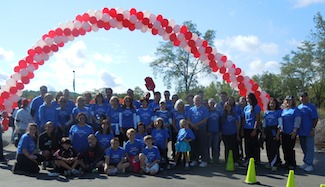 Sixty Scarsdale residents made big strides and raised a mountain of money for diabetes research this past weekend. On Sunday, September 30th, a group of neighbors from Edgewood took part in the American Diabetes Association Step Out: Walk to Stop Diabetes at Mercy College. Team Edgewood was the biggest team participating in the charity walk that day which included hundreds of people from around the county. The team raised over $10,000 for the charity-- more than any other team participating in the walk.
Sixty Scarsdale residents made big strides and raised a mountain of money for diabetes research this past weekend. On Sunday, September 30th, a group of neighbors from Edgewood took part in the American Diabetes Association Step Out: Walk to Stop Diabetes at Mercy College. Team Edgewood was the biggest team participating in the charity walk that day which included hundreds of people from around the county. The team raised over $10,000 for the charity-- more than any other team participating in the walk.
The inception of this fundraising team started with longtime Scarsdale resident, Margaret Marcus. She became involved in raising money for diabetes when her son’s close friend was diagnosed with the disease. She decided to raise money for the ADA since it is an all-inclusive charity that does not distinguish between Type I and Type II diabetes in terms of how it spends its money.
Marcus asked several local businesses for raffle prices to help raise money for her charity. She then went to her friends and neighbors for support. Not only was she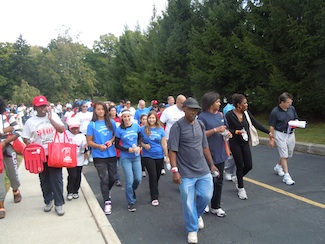 amazed by the generosity of those businesses, neighbors and friends who wanted to help her with her goal, but it seemed that many were also touched by diabetes with a friend or family member dealing with the disease. As it turns out, many wanted not only to help support Margaret financially with her goal. They also wanted to get involved by walking and raising money for a good cause.
amazed by the generosity of those businesses, neighbors and friends who wanted to help her with her goal, but it seemed that many were also touched by diabetes with a friend or family member dealing with the disease. As it turns out, many wanted not only to help support Margaret financially with her goal. They also wanted to get involved by walking and raising money for a good cause.
There is still time to contribute to Margaret and her team ... click here to join the fight.
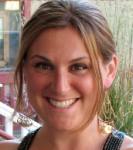 Jen is a freelance journalist who has covered the economy and markets for over a decade at a major financial news outlet. She lives in Scarsdale with her husband and 2 children. Jen has yet to bake a successful batch of cookies.
Jen is a freelance journalist who has covered the economy and markets for over a decade at a major financial news outlet. She lives in Scarsdale with her husband and 2 children. Jen has yet to bake a successful batch of cookies.
What Makes Susie Run .. and Why You Should Get Involved Too!
- Details
- Written by: Joanne Wallenstein
- Hits: 5688
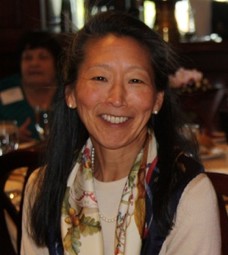 If you have ever volunteered in Scarsdale, you have undoubtedly run into Susie Rush, a person whose resume of volunteer activities is an equal match to her impressive professional credentials. Her list of community jobs can fill an entire page. She’s often sought out to help because she’s smart, diligent, patient, detail-oriented and willing to take on tasks that others turn down. I have worked with her on the League of Women Voters, the School Board Nominating Committee and the Citizen’s Nominating Committee – but those assignments are just a few of the jobs she has held. Her complete “volunteer” resume appears at the end of this piece.
If you have ever volunteered in Scarsdale, you have undoubtedly run into Susie Rush, a person whose resume of volunteer activities is an equal match to her impressive professional credentials. Her list of community jobs can fill an entire page. She’s often sought out to help because she’s smart, diligent, patient, detail-oriented and willing to take on tasks that others turn down. I have worked with her on the League of Women Voters, the School Board Nominating Committee and the Citizen’s Nominating Committee – but those assignments are just a few of the jobs she has held. Her complete “volunteer” resume appears at the end of this piece.
A graduate of the University of Pennsylvania law school and a former corporate attorney, Susie has been serving for the last eight years as a Legislative Analyst to State Assemblywoman Amy Paulin working on legislation that Paulin proposes to be enacted into law. But neither her job, nor her family responsibilities have stopped Susie from continuing to volunteer. Among other things, she is currently Treasurer of the Scarsdale Foundation, First Vice President of the Scarsdale League of Women Voters, on the boards of Scarsdale Edgemont Family Counseling Service, the Scarsdale Forum, and the League of Women Voters of Westchester, the Publicity Chair for the Youth Employment Service of Scarsdale, and a member of the Coalition against Domestic Violence.
In an effort to highlight people in the community who do more than their fair share, we reached out to Susie to find out what makes her run – or rush as the case may be. Though she was initially reluctant to be featured on the site, she eventually relented. Here is what she shared.
Where did you grow up and go to high school? I grew up in a suburb just outside Columbus, Ohio. I attended the local public high school, Northland H.S.
As a student, were you self-motivated or did your parents pressure/encourage you to do well? I don’t ever remember either of my parents telling me I had to do well, but somehow I knew it was expected. It may have been because my older brother did well so I knew I had to do well too. I was a pretty diligent student, practiced a lot (I played flute in the band and orchestra and piccolo in the marching band) and got involved in a lot of extracurricular activities. I enjoyed being busy.
As a parent, do you think your parenting style is similar to your parents? I think my parents were a lot less child-centric. Kids weren’t the focus of attention and were meant more to be seen rather than heard. At the same time, my brother and I were expected to contribute to the running of the house, especially because both of my parents worked full-time. There was never a question that we had to do chores, without excuse or complaint. I, on the other hand, never insisted on requiring my sons to do any chores. I made the mistake of thinking their time was more valuable than mine (“oh, he’s doing his homework so I can’t make him do that”). I didn’t drag them on errands even if it was on the way home with them because I didn’t want them to be inconvenienced. How silly is that?
Did you practice law after you graduated and if so, where? After law school, I started out at a small law firm on Wall Street, practicing a little bit of everything – corporate, real estate, and trusts and estates law. I moved to a firm midtown where I became a partner specializing in corporate law – mergers and acquisitions, venture capital, public offerings and bank financings.
What made you decide to leave the law – if you did? When we knew we were going to have our second child, we wanted to leave the city for the suburbs. I didn’t want to get a call from the nurse’s office that my son, just starting kindergarten, was sick and I’d be stuck on a train to Scarsdale. I also knew that it would be impossible to do my job well as a corporate attorney if I had to leave the office by 5. 5 in the afternoon was when a lot of our corporate clients would start calling us! I didn’t want both my husband, who was an investment banker at the time, and me coming home late every night. One of us had to be around and I wanted to be the one. I continued to practice law after we moved here, as general counsel to a software company in Westchester. That job provided me with reasonable working hours and the proximity I needed. Unfortunately, that company was acquired by Oracle and its nearest corporate office was in New Jersey. There was no way I was going to go back and forth on the Tappan Zee. So I worked as an independent contractor for another few years. I finally stopped because I was doing too much and trying to do it all perfectly and ended up feeling either completely inadequate or exhausted.
What initially attracted you to Scarsdale and when did you move here? We looked at the towns with the shortest commute time from the city and the best public schools.
How old were your children at the time? Our oldest was a little over 4 and my youngest was 2 months old.
Did you get into volunteering immediately? No, I was too overwhelmed with getting settled in to the suburban life, finding a reliable sitter (that was a nightmare) and DRIVING everywhere. I really missed being able to walk everywhere. I often found myself close to tears because I was always getting lost.
What motivates you to take on so many community responsibilities? Scarsdale is such a wonderful community in so many ways. I’ve always believed we should give back in whatever way we can.
From your resume, it looks like you have taken on almost every task imaginable here - which activities have you found the most rewarding and which have been the toughest? I started out with one, putting out the Quaker Ridge PTA newsletter back in the days when it was on paper and got sent home in the backpacks. That led to something else, which led to something else, and I just kept going. It’s difficult to single out the most rewarding activity since so many have been rewarding, but one of the most personally gratifying would certainly be my tenure as PT Council President. Serving in that role gave me the opportunity to work with outstanding individuals, including district and school administrators and staff, school board members, teachers, and PTA leaders. It truly was a privilege. The toughest had to be serving as PTA President at Quaker Ridge when 9/11 occurred. It was obviously a devastating time and I wanted to do what I could to help our community come together in support of each other.
Now that you work for Amy Paulin have you had to cut back your volunteer activities? As it happens, when I started working for Amy, I got the sense that parents weren’t as “needed” a presence at either the Middle School or the High School as they might have been at elementary school. And my son who’s at the high school now definitely does not like to see me there. So I stay active volunteering with community organizations such as the League of Women Voters and the Scarsdale Foundation.
How many hours a week to you work for Amy? Do you draft legislation for her? Although I’m technically a part-timer, at times I feel like I’m working full-time. But that’s probably because of my personality (I have a hard time saying no). Amy comes up with ideas for legislation from a variety of sources –- articles in the media, constituents, advocates, focused examination of issues she’s interested in, and sometimes one of us in the office will have an issue that we want to address. Once there’s an idea for legislation, I work with Amy and the relevant stakeholders to draft legislation and negotiate with various parties to come up with a bill that can pass both houses and ultimately be signed by the Governor. It can be a painstaking, often frustrating process, but Amy is incredibly dogged and astute at getting bills done. I don’t think people realize how difficult the process is and how effective she is at it.
How has your background as a lawyer helped you in your volunteer work and your current work as a legislative analyst? There are a number of skills one develops as a corporate lawyer – communicating effectively, listening, advocating a position but having the flexibility to compromise, analyzing and synthesizing a lot of information, crafting solutions that meet the needs of the client but that are also acceptable to the other parties involved, being patient and persistent … doing whatever has to be done to get the deal done. All of these are valuable tools to help reach one’s objective, whether it’s in a volunteer or professional setting.
What are your plans for the future? Still too early to tell. But there is one thing I plan to do - go back to Africa with our kids and their significant others. We went on a safari last year and it was the best trip we’ve ever had.
What do you do for fun? Travel? Exercise? Good food and wine with good friends, reading a great historical fiction novel. Exercise? I did none until I moved here. I took up a bunch of things over time (mainly because it seemed all I was doing was eating or sitting in a car or at a meeting) – running, tennis, golf, yoga and “going to the gym” -- to varying degrees of success. All exact some form of pain – mental or physical – but I couldn’t see giving any of them up. I love spending as much time as I can in Kiawah, SC where there’s all of the above plus biking, beach and great food, and for some reason not as much pain!
What would you tell new parents moving to Scarsdale about getting involved? I think it can be incredibly overwhelming to move here, especially if it’s the first time living in the suburbs and you’re coming from the city. So I’d say to those new to Scarsdale to resist the inclination to stay home and get settled in. Instead of unpacking the last boxes, go for coffee with your neighbor, sign up to have a buddy at school assigned to you, play Rec tennis, join a book club. Go to a PTA meeting and find out about your child’s school and the volunteer opportunities there – you can also ask the PTA president or the class mom of your child’s class -- so that you find something that fits. Get involved right away! If not with the PTA at your child’s school, maybe the local temple or church or one of the community organizations like the League of Women Voters of Scarsdale or the Junior League who always welcome new members and are happy with whatever time you can give. You can start with one activity and see how it goes. Whether you work outside the home or at home, you can find something that is manageable for you. When you do find that something, you’ll discover not only that there are people who share your interests, background and experiences but also that the work you’re doing is rewarding. After a couple of years, I would also suggest getting involved in the nonpartisan election system like the school board nominating committee. Serving on the SBNC is a wonderful way to meet people outside your particular school area with diverse backgrounds and ages, and provides you with the opportunity to learn about the governance of our school system and to play a vital role in selecting the individuals responsible for developing and managing the $141+M budget for the school district and setting policy for our schools. Lastly, I’d say take a moment just for yourself once a day or at least once a week to read, exercise or just be.
For me, feeling comfortable and getting involved go hand in hand - getting involved is the best way to feel at ease in your new community, and the more comfortable you are, the more involved you’ll be. And I am certain that as you volunteer, you will be fortunate to meet and work with the many, many wonderful role models who give tirelessly to our community who will inspire you to do even more. (Then you’ll have to ask them how to say “no”!)
More about Susie:
Currently Susie is Treasurer and Trustee, Scarsdale Foundation; First Vice President and Director, League of Women Voters of Scarsdale; Coordinator, Candidates Forums, and Director, League of Women Voters of Westchester; Director, Scarsdale Family Counseling Service and Scarsdale Forum; Member, Coalition against Domestic Violence; HS PTA Liaison, Scarsdale Task Force on Drugs & Alcohol; and Publicity Chair, Youth Employment Service of Scarsdale. She also serves on the University of Pennsylvania Alumni Secondary Schools Committee. Previously, she has served as a moderator in League of Women Voters candidates’ forum and in a number of capacities for the Scarsdale League of Women Voters. She has also served as: Chair, Budget Committee, League of Women Voters of Westchester; Co-chair, Scarsdale Foundation Scholarship Committee; President, Scarsdale PT Council; President, Quaker Ridge PTA; Chair, Scarsdale High School PTA Scholarship Fund for College; Member and Chair, Scarsdale Bowl Committee; Member and Chair, Scarsdale School Board Nominating Committee; Member, Administrative Committee, Joint Committee, Citizens’ Nominating Committee, and Procedure Committee; Member, Interdependence Institute, STI Policy Board, Scarsdale Teen Center Adult Board, STEP Board; member and chair various committees Quaker Ridge, SMS and SHS PTAs; and Director, Kid’s B.A.S.E. and The Little School.
Where Were You When the Lights Went Out?
- Details
- Written by: Joanne Wallenstein
- Hits: 7813
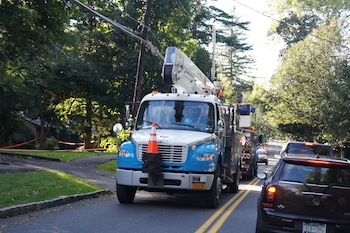 After a spate of days of cool, dry, September sunshine, Westchester was hit with a scary storm on Tuesday evening. High winds and strong downpours had everyone fearing the worst. During one strong gust we heard a crack and something hit the roof. We peered outside into the darkness and eventually made out a big branch in the yard – but the branch had fallen in an open spot and the damage appeared to be minimal.
After a spate of days of cool, dry, September sunshine, Westchester was hit with a scary storm on Tuesday evening. High winds and strong downpours had everyone fearing the worst. During one strong gust we heard a crack and something hit the roof. We peered outside into the darkness and eventually made out a big branch in the yard – but the branch had fallen in an open spot and the damage appeared to be minimal.
Our friends on Greenacres Avenue were not so fortunate. At 6:30 pm on Tuesday a large tree fell at the corner of Kingston and Greenacres Avenue and knocked out the power for a section of homes on the northern border of Greenacres. They spent their evening in the dark but their power was restored about four hours later and we all went to sleep thinking the worst was over.
Wednesday dawned cooler but bright and I hunkered down on the computer to make up for lost time. I was making good

Not so bad I thought – I assumed the outage would only last a few minutes while Con Edison made a quick fix. Quickly rearranging my day I decided to go out and shoot some photos. As I prepared to leave the house I glanced out the garage door – which was closed. Ugh! We have an automatic door and my husband said we had misplaced the key. With no electricity and without any other access to the garage, the cars were locked inside.
My options for the day were dwindling and by now an hour had passed with no sign of the power. I decided to take a walk to see if I could figure anything out – and after stopping a few joggers I found out that Con Edison was at work at Walworth and Fenimore Roads. I asked one of the men in the truck when the power would be restored and he was vague – mumbling something about later tonight. He also revealed that Con Edison had turned off the power for a portion of Greenacres and Fox Meadown in order to make a repair caused by a downed tree at Fenimore and Brite Avenue. The stoplights were out too – and police were stationed at every corner directing the snarled traffic to a detour as Fenimore Road was closed.
What happened to Con Edison’s robo-calls and the Village emergency system? I’ll never know as my phone line was out as well. I contacted both the police and the village and both said that the storm had affected very few customers. From what I saw, I was among more than a few who were inconvenienced. The power finally returned at 6:30 pm – an eight-hour outage without a word from the authorities. Hmmmmm.
In response to my inquiries I received this email from the Village this morning:
Because the storm did not cause a great deal of damages or outages, Con Edison did not assign a liaison to the Village to update us on the status of local power outages. Nevertheless, the Village was in contact with Con Ed and as of last night all of the power outages restored with the exception of a section of Greenacres, which is estimated to be restored by 11AM today. The best way to track where power outages are and estimated times for restoration is Con Edison’s website .
Scarsdale's Finbar Kantor Excels in Fiddle Competition
- Details
- Hits: 6533
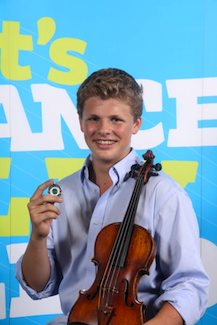 Finbar Kantor, a junior at SHS placed third in the fiddle slow airs category at the All Ireland Fleadh held in Cavan Ireland in August, 2012. He played Where You at the Rock and The Sweet Irish Boy. Finbar, a Scarsdale High School junior, studies classical violin at Hoff Barthelson Music School and Irish fiddle with renowned Irish fiddler Brian Conway. Finbar plays weekly at Brian Conways traditional Irish session at Dunne's Pub in White Plains.
Finbar Kantor, a junior at SHS placed third in the fiddle slow airs category at the All Ireland Fleadh held in Cavan Ireland in August, 2012. He played Where You at the Rock and The Sweet Irish Boy. Finbar, a Scarsdale High School junior, studies classical violin at Hoff Barthelson Music School and Irish fiddle with renowned Irish fiddler Brian Conway. Finbar plays weekly at Brian Conways traditional Irish session at Dunne's Pub in White Plains.










